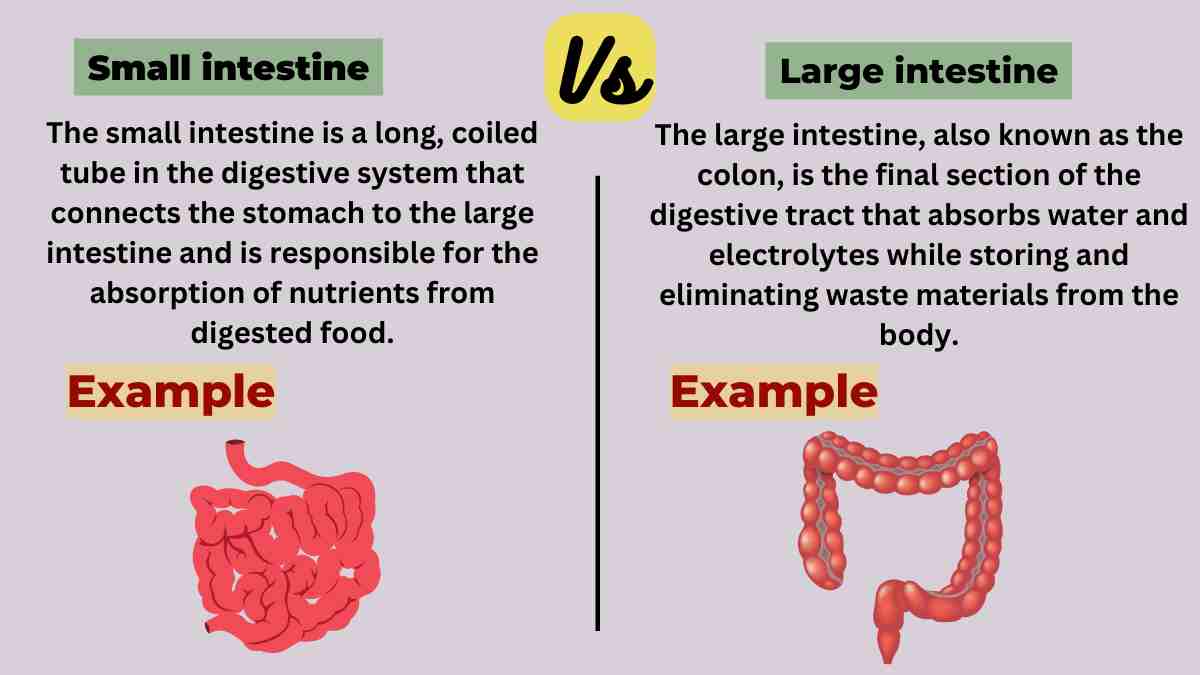The key difference between small intestine and large intestine is their size and function. The small intestine is longer and narrower, responsible for the majority of nutrient absorption, while the large intestine is shorter and wider, primarily involved in water absorption and the formation of feces.

In this article, we will discuss the difference between small intestines and large intestines. We will also give deep insight into separately on both.
What is the Small intestine?
The small intestine is a long, coiled tube in the digestive system that connects the stomach to the large intestine and is responsible for the absorption of nutrients from digested food.
It plays an important role in nutrient absorption from food and helps break down proteins, fats, and carbohydrates. The small intestine is around 20 feet long in adults and consists of three sections: the duodenum, jejunum, and ileum.
Its inner lining contains tiny finger-like projections called villi, which increase surface area for efficient nutrient absorption into the bloodstream.
What is a Large intestine?
The large intestine, also known as the colon, is the final section of the digestive tract that absorbs water and electrolytes while storing and eliminating waste materials from the body.
It is a tube-like organ that measures about 5 feet in length in adults. Its primary function is to absorb water and electrolytes from undigested food, converting it into solid waste (feces) before elimination from the body.
The large intestine harbors beneficial bacteria that aid in digestion and supports the immune system. nt absorption into the bloodstream.
Small intestine vs Large intestine
The key difference between small intestine and large intestine is given below:
| Small Intestine | large Intestine | |
| Location | Extends from the stomach to the large intestine. | Extends from the small intestine to the anus. |
| Length | Approximately 20 feet (6 meters) long. | Approximately 5 feet (1.5 meters) long. |
| Diameter | Smaller diameter than the large intestine | Larger diameter than the small intestine. |
| Structure | Consists of three parts: duodenum, jejunum, and ileum. | Consists of four parts: cecum, colon (ascending, transverse, descending, and sigmoid), and rectum. |
| Function | Main site of nutrient absorption. | Absorbs water, electrolytes, and some vitamins; stores and eliminates indigestible materials (feces). |
| Villi | Contains numerous villi (finger-like projections) to increase surface area for absorption. | Lacks villi; the inner surface is relatively smooth. |
| Digestive Enzymes | Secretes various digestive enzymes. | Does not secrete digestive enzymes. |
| Muscle Layer | Has a thicker muscle layer for peristalsis and mixing. | Has a thinner muscle layer compared to the small intestine |
| Presence of Appendix | Does not have an appendix. | Contains the appendix, a small finger-like projection. |
| Bacterial Flora | Contains fewer bacteria. | Contains a large population of beneficial bacteria. |
